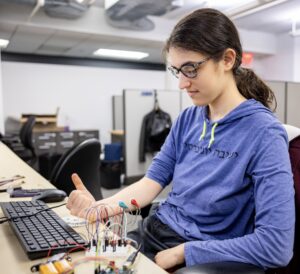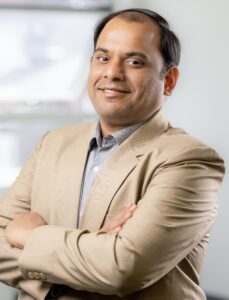 Biotechnology student Natania Birnbaum measures surface electromyography (sEMG) signals generated by balling her fist. Photos by Denton Field
Biotechnology student Natania Birnbaum measures surface electromyography (sEMG) signals generated by balling her fist. Photos by Denton FieldBy David DeFusco
Exoskeletons have been the stuff of science fiction as far back as the War of the Worlds, enabling fictional robots to outgun and outwit their nemeses. Real-world exoskeletons, like the one being developed by Natania Birnbaum, a student in the M.S. in Biotechnology Management and Entrepreneurship, tend to be simpler devices developed with the goal of helping people, paralyzed by illness or spinal injury, use their limbs.
Under the guidance of Dr. Sai Praveen Kadiyala, Birnbaum is building a prototype for a hand exoskeleton that can take surface electromyography (sEMG) signals from the muscles of the arm and use them to move the exoskeleton's fingers. The aim of this work, as they explained at the Katz School’s Symposium on Science, Technology and Health in May, is to create a computational model of complex hand gestures and other fine motor skills for an exoskeleton that will assist in upper-limb rehabilitation.
 The prototype of an exoskeleton that when perfected will allow stroke victims to manipulate objects with their hands.
The prototype of an exoskeleton that when perfected will allow stroke victims to manipulate objects with their hands.“Stroke patients often lose motor function in their hands, affecting their ability to perform everyday tasks,” said Birnbaum. “Robot-assisted therapies hold promise because they are convenient and cost-effective for the patient and therapist, make data collection from the treatment much easier, and increase patient motivation. However, conventional robots are often bulky and uncomfortable and don’t adapt to a patient’s body.”
Robots utilizing sEMG, in which muscle activity is detected through micro-voltages generated through the skin, have the potential to address these issues. Although a stroke survivor may not be able to move their muscles, they may still produce weak sEMG signals that a lightweight device can use to assist in moving the hand and helping it regain function.
Dr. Kadiyala praised Birnbaum and the collaborative efforts of his student team, including biotech graduate Amena Farooq and data analytics graduates Ziyang Guo and Ke Chen, that created a regression analysis to express the complex grasps of activities for daily living as a combination of primitive gestures.
“By determining the weights of different primitive gestures in activities of daily living, this research helps build optimal exoskeletons that can offer effective stroke rehabilitation,” said Dr. Kadiyala. “The research is also helping to create custom-design tasks that mimic activities of daily living, thus offering effective rehabilitation.”
 Dr. Sai Praveen Kadiyala, a postdoctoral research fellow in the M.S. in Artificial Intelligence, supervised the research.
Dr. Sai Praveen Kadiyala, a postdoctoral research fellow in the M.S. in Artificial Intelligence, supervised the research.During the research, Birnbaum placed electrodes on her own arm to perform certain gestures like balling her fist. The sEMG signals from those muscles were then converted into a digital signal by sensors connected to the electrodes. The relative signal strengths of the sensors on different parts of her arm helped build a model to predict how the exoskeleton should move. Birnbaum collected sEMG data on five basic gestures and 10 complex grasps that are used in activities of daily living, repeating each gesture multiple times.
“There are many muscles in the arm, but the ones I’m trying to measure are the flexors connected to the radius and ulna bones of the forearm which are in charge of moving the fingers,” said Birnbaum. “This project is great because you get to see how much you don't know, and you realize how complicated everything is in the body.”
Birnbaum, who holds a B.S. in biology from YU’s Stern School for Women, said her research complements the classes she’s been taking in the biotechnology master’s program because it seeks to measure the activity—the inner life—of living cells which she routinely observes under a microscope.
She enrolled in the Katz School’s M.S. in Biotechnology Management and Entrepreneurship program through YU’s Pathways program. The Pathways program allows YU undergraduates to take graduate-level courses in their senior year, accelerating the time for completion of two degrees. Students also benefit from a reduction in tuition since they take graduate courses as part of their undergraduate program.
In addition to the Katz School, Pathways offers entry into graduate programs at YU’s Azrieli Graduate School of Jewish Education & Administration; Bernard Revel Graduate School of Jewish Studies; Emil A. and Jenny Fish Center for Holocaust & Genocide Studies; Ferkauf Graduate School of Psychology; Sy Syms School of Business; and Wurzweiler School of Social Work.
Rana Khan, program director of the M.S. in Biotechnology Management and Entrepreneurship, described Pathways students as smart, motivated and driven. “Coming with a solid foundation in biological sciences, they absorb the business and entrepreneurship aspects of our program really quickly and come up with potential commercial applications,” she said. “Because Natania was a biology major and computer science minor, she was an excellent fit for a project like this one, where students can apply their knowledge and skills from more than one discipline.”
